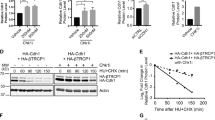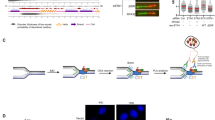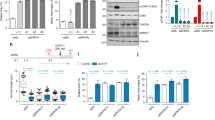Abstract
Here, we show that the human homologue of the Caenorhabditis elegans biological clock protein CLK-2 (HCLK2) associates with the S-phase checkpoint components ATR, ATRIP, claspin and Chk1. Consistent with a critical role in the S-phase checkpoint, HCLK2-depleted cells accumulate spontaneous DNA damage in S-phase, exhibit radio-resistant DNA synthesis, are impaired for damage-induced monoubiquitination of FANCD2 and fail to recruit FANCD2 and Rad51 (critical components of the Fanconi anaemia and homologous recombination pathways, respectively) to sites of replication stress. Although Thr 68 phosphorylation of the checkpoint effector kinase Chk2 remains intact in the absence of HCLK2, claspin phosphorylation and degradation of the checkpoint phosphatase Cdc25A are compromised following replication stress as a result of accelerated Chk1 degradation. ATR phosphorylation is known to both activate Chk1 and target it for proteolytic degradation, and depleting ATR or mutation of Chk1 at Ser 345 restored Chk1 protein levels in HCLK2-depleted cells. We conclude that HCLK2 promotes activation of the S-phase checkpoint and downstream repair responses by preventing unscheduled Chk1 degradation by the proteasome.
This is a preview of subscription content, access via your institution
Access options
Subscribe to this journal
Receive 12 print issues and online access
$209.00 per year
only $17.42 per issue
Buy this article
- Purchase on Springer Link
- Instant access to full article PDF
Prices may be subject to local taxes which are calculated during checkout








Similar content being viewed by others
References
Bekker-Jensen, S. et al. Spatial organization of the mammalian genome surveillance machinery in response to DNA strand breaks. J. Cell Biol. 173, 195–206 (2006).
Stucki, M. & Jackson, S. P. γH2AX and MDC1: anchoring the DNA-damage-response machinery to broken chromosomes. DNA Repair 5, 534–543 (2006).
Kastan, M. B. & Bartek, J. Cell-cycle checkpoints and cancer. Nature 432, 316–323 (2004).
Zhou, B. B. & Elledge, S. J. The DNA damage response: putting checkpoints in perspective. Nature 408, 433–439 (2000).
Zou, L. & Elledge, S. J. Sensing DNA damage through ATRIP recognition of RPA-ssDNA complexes. Science 300, 1542–1548 (2003).
Shiloh, Y. ATM and related protein kinases: safeguarding genome integrity. Nature Rev. Cancer 3, 155–168 (2003).
Kennedy, R. D. & D'Andrea, A. D. The Fanconi Anemia/BRCA pathway: new faces in the crowd. Genes Dev. 19, 2925–2940 (2005).
Antoch, M. P., Kondratov, R. V. & Takahashi, J. S. Circadian clock genes as modulators of sensitivity to genotoxic stress. Cell Cycle 4, 901–907 (2005).
Fu, L., Pelicano, H., Liu, J., Huang, P. & Lee, C. The circadian gene Period2 plays an important role in tumor suppression and DNA damage response in vivo. Cell 111, 41–50 (2002).
Gery, S. et al. The circadian gene per1 plays an important role in cell growth and DNA damage control in human cancer cells. Mol. Cell 22, 375–382 (2006).
Pregueiro, A. M., Liu, Q., Baker, C. L., Dunlap, J. C. & Loros, J. J. The Neurospora checkpoint kinase 2: a regulatory link between the circadian and cell cycles. Science 313, 644–649 (2006).
Ahmed, S., Alpi, A., Hengartner, M. O. & Gartner, A. C. elegans RAD-5/CLK-2 defines a new DNA damage checkpoint protein. Curr. Biol. 11, 1934–1944 (2001).
Garcia-Muse, T. & Boulton, S. J. Distinct modes of ATR activation after replication stress and DNA double-strand breaks in Caenorhabditis elegans. EMBO J. 24, 4345–4355 (2005).
Early, A., Drury, L. S. & Diffley, J. F. Mechanisms involved in regulating DNA replication origins during the cell cycle and in response to DNA damage. Philos. Trans. R. Soc. Lond. B Biol. Sci. 359, 31–38 (2004).
Polanowska, J., Martin, J. S., Garcia-Muse, T., Petalcorin, M. I. & Boulton, S. J. A conserved pathway to activate BRCA1-dependent ubiquitylation at DNA damage sites. EMBO J. 25, 2178–2188 (2006).
Brown, E. J. & Baltimore, D. ATR disruption leads to chromosomal fragmentation and early embryonic lethality. Genes Dev. 14, 397–402 (2000).
Kim, J. E., McAvoy, S. A., Smith, D. I. & Chen, J. Human TopBP1 ensures genome integrity during normal S phase. Mol. Cell Biol. 25, 10907–10915 (2005).
Syljuasen, R. G. et al. Inhibition of human Chk1 causes increased initiation of DNA replication, phosphorylation of ATR targets, and DNA breakage. Mol. Cell Biol. 25, 3553–3562 (2005).
Jaspers, N. G. & Zdzienicka, M. Z. Inhibition of DNA synthesis by ionizing radiation: a marker for an S-phase checkpoint. Methods Mol. Biol. 314, 51–59 (2006).
Brown, E. J. & Baltimore, D. Essential and dispensable roles of ATR in cell cycle arrest and genome maintenance. Genes Dev. 17, 615–628 (2003).
Chini, C. C. & Chen, J. Human claspin is required for replication checkpoint control. J. Biol. Chem. 278, 30057–30062 (2003).
Goldberg, M. et al. MDC1 is required for the intra-S-phase DNA damage checkpoint. Nature 421, 952–956 (2003).
Lou, Z., Minter-Dykhouse, K., Wu, X. & Chen, J. MDC1 is coupled to activated CHK2 in mammalian DNA damage response pathways. Nature 421, 957–961 (2003).
Stewart, G. S., Wang, B., Bignell, C. R., Taylor, A. M. & Elledge, S. J. MDC1 is a mediator of the mammalian DNA damage checkpoint. Nature 421, 961–966 (2003).
Xu, B., Kim, S. & Kastan, M. B. Involvement of Brca1 in S-phase and G(2)-phase checkpoints after ionizing irradiation. Mol. Cell Biol. 21, 3445–3450 (2001).
Liu, Q. et al. Chk1 is an essential kinase that is regulated by Atr and required for the G(2)/M DNA damage checkpoint. Genes Dev. 14, 1448–1459 (2000).
Lam, M. H., Liu, Q., Elledge, S. J. & Rosen, J. M. Chk1 is haploinsufficient for multiple functions critical to tumor suppression. Cancer Cell 6, 45–59 (2004).
Takai, H. et al. Aberrant cell cycle checkpoint function and early embryonic death in Chk1−/− mice. Genes Dev. 14, 1439–1447 (2000).
Andreassen, P. R., D'Andrea, A. D. & Taniguchi, T. ATR couples FANCD2 monoubiquitination to the DNA-damage response. Genes Dev. 18, 1958–1963 (2004).
Stiff, T. et al. Nbs1 is required for ATR-dependent phosphorylation events. EMBO J. 24, 199–208 (2005).
Wang, X. et al. Chk1 mediated phosphorylation of FANCE is required for the Fanconi Anemia/BRCA pathway. Mol. Cell Biol. doi: 10.1128/MCB.02357-06 (2007).
Garcia-Higuera, I. et al. Interaction of the Fanconi anemia proteins and BRCA1 in a common pathway. Mol. Cell 7, 249–262 (2001).
Collis, S. J., Barber, L. J., Ward, J. D., Martin, J. S. & Boulton, S. J. C. elegans FANCD2 responds to replication stress and functions in interstrand cross-link repair. DNA Repair 5, 1398–1406 (2006).
Sorensen, C. S. et al. The cell-cycle checkpoint kinase Chk1 is required for mammalian homologous recombination repair. Nature Cell Biol. 7, 195–201 (2005).
Johnson, R. D. & Jasin, M. Double-strand-break-induced homologous recombination in mammalian cells. Biochem. Soc. Trans. 29, 196–201 (2001).
Saleh-Gohari, N. et al. Spontaneous homologous recombination is induced by collapsed replication forks that are caused by endogenous DNA single-strand breaks. Mol. Cell Biol. 25, 7158–7169 (2005).
Zhao, H. & Piwnica-Worms, H. ATR-mediated checkpoint pathways regulate phosphorylation and activation of human Chk1. Mol. Cell Biol. 21, 4129–4139 (2001).
Bartek, J., Lukas, C. & Lukas, J. Checking on DNA damage in S phase. Nature Rev. Mol. Cell Biol. 5, 792–804 (2004).
Chini, C. C., Wood, J. & Chen, J. Chk1 is required to maintain Claspin stability. Oncogene 25, 4165–4171 (2006).
Kumagai, A. & Dunphy, W. G. Claspin, a novel protein required for the activation of Chk1 during a DNA replication checkpoint response in Xenopus egg extracts. Mol. Cell 6, 839–849 (2000).
Rao, V. A. et al. Phosphorylation of BLM, dissociation from topoisomerase IIIα, and colocalization with γ-H2AX after topoisomerase I-induced replication damage. Mol. Cell Biol. 25, 8925–8937 (2005).
Zhang, Y. W. et al. Genotoxic stress targets human Chk1 for degradation by the ubiquitin-proteasome pathway. Mol. Cell 19, 607–618 (2005).
Tercero, J. A. & Diffley, J. F. Regulation of DNA replication fork progression through damaged DNA by the Mec1/Rad53 checkpoint. Nature 412, 553–557 (2001).
Howlett, N. G., Taniguchi, T., Durkin, S. G., D'Andrea, A. D. & Glover, T. W. The Fanconi anemia pathway is required for the DNA replication stress response and for the regulation of common fragile site stability. Hum. Mol. Genet. 14, 693–701 (2005).
O'Driscoll, M., Ruiz-Perez, V. L., Woods, C. G., Jeggo, P. A. & Goodship, J. A. A splicing mutation affecting expression of ataxia-telangiectasia and Rad3-related protein (ATR) results in Seckel syndrome. Nature Genet. 33, 497–501 (2003).
Dimitrova, D. S. & Gilbert, D. M. Temporally coordinated assembly and disassembly of replication factories in the absence of DNA synthesis. Nature Cell Biol. 2, 686–694 (2000).
Feijoo, C. et al. Activation of mammalian Chk1 during DNA replication arrest: a role for Chk1 in the intra-S phase checkpoint monitoring replication origin firing. J. Cell Biol. 154, 913–923 (2001).
Jiang, N., Benard, C. Y., Kebir, H., Shoubridge, E. A. & Hekimi, S. Human CLK2 links cell cycle progression, apoptosis, and telomere length regulation. J. Biol. Chem. 278, 21678–21684 (2003).
Acknowledgements
We wish to thank: A. Jones and H. Cooper for mass-spectrometry; Y. Murakawa and S. Takeda for laser micro-irradiation experiments; S. Hekimi, S. West, N. Lakin, G. Smith, S. Jackson and A. Jazayeri for HCLK2, Rad51, ATR, ATRIP and Cdc25A antibodies, respectively; N. Mailand, J. Bartek, H. Piwnica-Worms, Y.-W. Zhang and B. Abraham for Chk1 constructs; H. Bryant and T. Helleday for SW480sn3 cells, ISce-1 and GFP-reporter plasmids; N. O'Reilly for peptide synthesis; and R. Peat and R. Horton-Harpin for cell culture. Thanks to J. Svejstrup, P.Zegerman, A. Jazayeri, G. Alderton, J. Falck, P. Robins, M. Segurado and members of the Boulton lab for technical advice and comments on the manuscript. This work was funded by Breast Cancer Campaign (GA3221) and Cancer Research UK.
Author information
Authors and Affiliations
Contributions
S.J.C. performed the majority of experiments. L.J.B., A.J.C., J.S.M. and J.D.W. all contributed to the experiments. S.J.B., S.J.C. and L.J.B. contributed intellectually to this work.
Corresponding author
Ethics declarations
Competing interests
The authors declare no competing financial interests.
Supplementary information
Supplementary Information
Supplementary Figures S1, S2, S3, S4 and S5 (PDF 612 kb)
Rights and permissions
About this article
Cite this article
Collis, S., Barber, L., Clark, A. et al. HCLK2 is essential for the mammalian S-phase checkpoint and impacts on Chk1 stability. Nat Cell Biol 9, 391–401 (2007). https://doi.org/10.1038/ncb1555
Received:
Accepted:
Published:
Issue Date:
DOI: https://doi.org/10.1038/ncb1555
This article is cited by
-
The human nucleoporin Tpr protects cells from RNA-mediated replication stress
Nature Communications (2021)
-
Cdc7-Dbf4-mediated phosphorylation of HSP90-S164 stabilizes HSP90-HCLK2-MRN complex to enhance ATR/ATM signaling that overcomes replication stress in cancer
Scientific Reports (2017)
-
Sterigmatocystin-induced checkpoint adaptation depends on Chk1 in immortalized human gastric epithelial cells in vitro
Archives of Toxicology (2017)
-
ATM-mediated stabilization of ZEB1 promotes DNA damage response and radioresistance through CHK1
Nature Cell Biology (2014)
-
Cell cycle progression in response to oxygen levels
Cellular and Molecular Life Sciences (2014)



